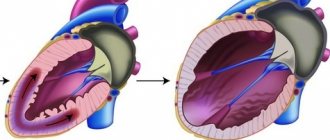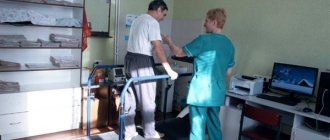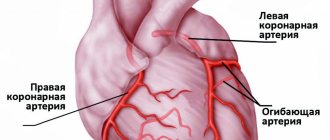Throughout life, the human heart constantly pumps blood, which supplies the body with oxygen and nutrients. This whole process occurs thanks to the coronary arteries (these are the vessels of the heart through which blood circulates).
Heart attack
When blood flow in one of these arteries is blocked, a serious condition called a myocardial infarction or heart attack occurs. As a result, little blood flows to the area of the heart where blood flow is blocked, and the heart muscle becomes weak. At the same time, the person feels severe pain in the heart.
Most often, men over 45 years of age and women over 50 years of age are susceptible to heart attacks. But among patients who have had a heart attack, there are also younger people. Lifestyle and risk factors contribute to the onset of the disease.
Causes of myocardial infarction
The main cause of myocardial infarction is coronary heart disease, which results in vascular atherosclerosis.
Atherosclerosis is a disease in which cholesterol accumulates on the walls of blood vessels. Fatty deposits or cholesterol enter the body with food, over time they are deposited in the form of plaques and interfere with blood flow.
This condition is associated with high cholesterol levels. Low-density lipoproteins are “bad” cholesterol, which is the cause of atherosclerosis. In addition to it, there is also “good” cholesterol - high-density lipoproteins, which protects the heart from cardiovascular diseases. It is “bad” cholesterol that accumulates on the walls of blood vessels.
Plaques can remain on blood vessels for many years, or they can block a heart vessel, causing myocardial infarction.
Myocardial infarction has many risk factors
- Age. It is believed that the risk of developing a heart attack increases with age. Most often this condition appears after 65 years of age.
- Floor. Myocardial infarction develops most often in men.
- Hypertension, or high blood pressure.
- A blood pressure reading of no more than 130/80 mmHg is considered normal. Pressure above 140/90 mm Hg. Art. is elevated. This indicator increases the risk of developing a heart attack.
- Diabetes. People with this condition also have a high risk of developing hypertension and high cholesterol, which can lead to heart attack.
- Heredity. Myocardial infarction occurs more often in people whose parents suffered from hypertension, high cholesterol, or had a heart attack.
- Excess weight, especially obesity.
- Sedentary lifestyle. Sports and any exercises tone blood vessels and strengthen them. With a lack of physical activity, cholesterol quickly accumulates on the walls of blood vessels. It has been proven that people who lead a sedentary lifestyle are twice as likely to suffer heart attacks.
- Bad habits.
Frequent drinking of alcohol increases the risk of heart attacks. Smoking is also dangerous for the heart. Addiction to tobacco causes high blood pressure and also increases the risk of blood clots.
Heart Attack Symptoms
Signs of myocardial infarction vary. It may be mild pain and discomfort. Severe pain also occurs. But there are common symptoms that indicate a heart attack. The main symptom is chest pain. Pressing, burning, squeezing is how patients usually describe pain during a heart attack.
Often this pain radiates to the left arm, shoulder, jaw, neck or back. In this case, dizziness and headache, nausea and vomiting, and difficulty breathing are often observed.
During a heart attack, the pain lasts for several minutes and then may disappear. Then after a while it returns again with greater intensity. Patients with a heart attack often report sweating, palpitations, and anxiety.
Some people feel not so much pain as a feeling of heaviness and indigestion in the stomach. As a rule, the pain cannot be stopped with conventional vasodilators (validol, nitroglycerin), and sometimes even with narcotic drugs. In some cases, there may be fainting and loss of consciousness.
What is a heart attack and what do you need to know about it?
To pump blood, the heart constantly needs oxygen and nutrients. The two large coronary arteries supply oxygenated blood to the heart muscle. If one of these arteries or their branches suddenly becomes blocked, a certain part of the heart becomes starved of oxygen. This phenomenon is called cardiac ischemia.
In the case of prolonged cardiac ischemia, tissue that does not receive oxygen dies, which is actually called a heart attack, myocardial infarction, or, literally speaking, the death of the heart muscle.
Most heart attacks last for several hours, so don't wait to seek help if you suspect a heart attack. In some cases, heart attack symptoms may not appear at all, but most heart attacks cause chest pain. Other signs of a heart attack include:
- difficulty breathing;
- dizziness;
- fainting;
- nausea.
The pain that occurs during a heart attack can be compared to a feeling of compression of the heart. The pain may be constant or intermittent. It is also worth noting that the signs of a heart attack in women and men may be different.
Periods of heart attack
- Pre-infarction period. Lasts from a few minutes to months. During this period, attacks increase in pain intensity.
- The most acute period. It causes necrosis of the heart muscle. This period lasts up to several hours. The most acute period, during which the development of ischemia and necrosis of the heart muscle occurs, lasts up to several hours. It may have a typical or atypical course.
- Acute period. Lasts up to 10 days. Pain in the heart decreases, blood pressure may drop significantly and the temperature rises.
- Subacute period. Lasts about two months. During this period, scar formation occurs. There is no pain.
- Post-infarction period. The person does not feel pain. The ECG shows changes that remain for life.
Atypical forms of myocardial infarction
As mentioned above, the main symptom of a heart attack is chest pain. But there are other forms of heart attack that masquerade as other illnesses.
- Peripheral. This form is characterized by pain in the left arm and throat. At the same time, patients also note sweating and weakness.
- Asthmatic form. The symptoms are very similar to bronchial asthma - shortness of breath, cough and sputum appear.
- Abdominal. With this form of heart attack, a person experiences pain in the right hypochondrium, nausea and vomiting.
- Collaptoid. This form of heart attack is manifested by decreased blood pressure, dizziness, and darkening of the eyes. There is no pain in the heart.
The main signs of a heart attack in women and men
1. Chest discomfort - most heart attacks are accompanied by a feeling of discomfort in the central part of the chest that does not go away within a few minutes (pressure, squeezing or pain). 2. Discomfort in other areas of the upper body - pain or discomfort in one or both arms, back, neck, jaw or stomach. 3. Difficulty breathing (whether accompanied by a feeling of discomfort or not). 4. Cold sweat, nausea or dizziness.
The main sign of a heart attack in both men and women is pain or discomfort in the chest. However, women are more likely than men to experience other signs of a heart attack: difficulty breathing, nausea/vomiting, and back or jaw pain.
Complications after myocardial infarction
Most often, the heart muscle begins to recover immediately after a heart attack. This takes the muscle approximately 2-3 months.
A scar remains in the place where there was necrosis of the heart muscle. As a result, the heart cannot pump as much blood as it did before the heart attack, and the person may develop the complication of heart failure. Weakness, cough, swelling of the legs and shortness of breath appear.
In addition, quite often people who have had a heart attack may experience heart rhythm disturbances. These are conditions in which the heart rate becomes lower or higher than normal. Most often, after a heart attack, rhythm disturbances such as ventricular extrasystole (a disorder in which premature contraction of the ventricles of the heart occurs) occur. The presence of high blood pressure, diabetes and bad habits increases the risk of developing rhythm disturbances.
Cardiogenic shock is another serious complication of myocardial infarction. At the same time, blood pressure drops sharply - below 80 mm Hg, consciousness is impaired, the skin becomes blue (cyanosis), and the heart rate increases (tachycardia).
Myocardial infarction
Diagnostics
Like any other disease, a heart attack can be detected and diagnosed.
- The main diagnostic method is ECG (electrocardiogram). The procedure allows you to determine the area of the heart where the disorder occurred, as well as timely identify complications.
- Blood tests. Another important method for detecting myocardial infarction is blood donation (complete blood count, biochemical analysis). These analyzes look at some indicators that are important during a heart attack.
- Echocardiography. This is a heart diagnostic method that allows you to identify damage in the structures of the heart (valves, septum).
- Coronary angiography is an examination based on the X-ray principle. This type of diagnosis can determine in which coronary artery the disorder occurred and the area of the heart in which it is believed to occur.
How to treat myocardial infarction?
If you experience chest pain, you can help yourself before the ambulance arrives.
What to do if you have a heart attack?
- Take a nitroglycerin tablet under the tongue or one dose as an aerosol.
- Call "103".
- Give the patient an aspirin tablet to chew.
- Urgently transport the patient to the nearest hospital department for medical care.
Treatment for myocardial infarction includes: stopping the pain that occurs during a heart attack. Then the patient is prescribed anticoagulants and thrombolytics, which prevent necrosis of the heart muscle from growing.
It is important to prevent complications. As already mentioned, a heart attack can have life-threatening consequences. For this purpose, the patient is prescribed medications for arrhythmia and rhythm disturbances.
In addition to drug treatment, there are instrumental methods, for example, angioplasty. A stent is inserted through a special catheter, which inflates in the damaged vessel, pushing plaques towards the walls of the vessel. At the same time, blood flow is restored.
What is the difference between angina and myocardial infarction?
Most heart attack victims do not notice the warning signs of impending danger, which manifest themselves in the form of angina pectoris - chest pain, which is also caused by ischemia. The difference between angina and a heart attack is that with angina, blood flow is quickly restored, the pain goes away within minutes, and there is no permanent damage to the heart. During a heart attack, the blood flow is significantly reduced or completely blocked, the pain is constant, and without proper medical intervention, the heart muscle dies.
About 25% of all heart attacks occur suddenly, i.e. without previous symptoms. Sometimes they are associated with a phenomenon called “silent” ischemia - random interruptions in blood flow to the heart, which for unknown reasons are not accompanied by pain, although they can lead to damage to heart tissue. Silent ischemia is often observed in diabetic patients.
Forecast
The prognosis after a heart attack may vary, depending on the severity of the condition and lifestyle.
If the heart muscle is damaged sufficiently, it can be fatal. Patients who have had a heart attack are at high risk of having another attack.
You can avoid a second heart attack only by improving your lifestyle and following treatment. A heart attack increases the risk of developing other heart diseases, especially in older people, people with diabetes or vascular disease.
Life-threatening dangers and complications of myocardial infarction
Death before arrival at the hospital occurs in 25% of people with a heart attack; the remaining 75% are at risk of complications after a heart attack, which are:
- stroke;
- arrhythmia;
- heart failure;
- blood clots in the legs or heart;
- aneurysm.
It is worth noting that people who survive a heart attack without complications a few hours after the heart attack have a high chance of making a full recovery.
Recovery from a heart attack is always a difficult process, since any heart attack weakens the heart to a greater or lesser extent. Depending on the severity of the heart attack, further scarring of the heart, and the speed of medical care, a heart attack can lead to:
- heart failure, in which the heart cannot pump blood properly;
- arrhythmias or abnormal heart rhythms;
- cardiac arrest or sudden cardiac death (heart stops beating);
- cardiogenic shock (in which the heart is so damaged that the person is in shock);
- of death.
How to prevent myocardial infarction?
In order to prevent myocardial infarction, it is worth following prevention methods.
- Lead a healthy lifestyle, provide yourself with a varied diet low in “bad” cholesterol and high in fiber. It is worth reducing your intake of saturated fat, it should be less than 7% of total calories. But the source of healthy fats is to increase. To do this, you need to eat more omega-3 fatty acids.
- Quit smoking, limit consumption of alcoholic beverages.
- Control blood pressure - no more than 130/80 mmHg.
- Control your body weight. Excess weight is a big enemy of health. Your body mass index (BMI) should be 18.5-24.8.
- In addition to general recommendations for reducing the risk of myocardial infarction, there are also tips for those who have already suffered a heart attack.
The doctor may recommend that the patient take certain medications on an ongoing basis that will control the heart rhythm and prevent recurrent attacks (aspirin, ACE inhibitors, beta blockers).
Cardiomagnyl, 75 mg+15.2 mg, film-coated tablets, 100 pcs.
Takeda, Germany
Price from 173₽
Aspirin Cardio, 100 mg, enteric-coated tablets, 56 pcs.
Bayer, Germany
Price from 241₽
Thrombo ACC, 50 mg, enteric film-coated tablets, 100 pcs.
Bausch Health, Austria
Price from 96₽
Acecardol, 50 mg, enteric-coated tablets, 30 pcs.
Sintez, Russia
Price from 20₽
ASK-cardio, 100 mg, enteric-coated tablets, 30 pcs.
Medisorb, Russia
Price from 49₽
There are contraindications. Specialist consultation is required.
Treatment of myocardial infarction
Myocardial infarction
- an emergency disease in cardiology and serves as an indication for immediate hospitalization in intensive care.
The number one task for doctors is to restore blood flow
in a thrombosed vessel. They achieve this in different ways. The priority and most effective is surgical intervention - angioplasty with stenting of the affected area of the artery or coronary artery bypass grafting. In parallel, medications are used that inhibit the development of a blood clot - disaggregants (aspirin, clopidogrel) and anticoagulants (heparin), and if immediate surgery is not possible, thrombolytics - drugs that dissolve the blood clot (alteplase, prourokinase).
Pain relief
carried out with narcotic analgesics, neuroleptics, intravenous infusions of nitroglycerin.
The size of the necrosis zone can be reduced by reducing myocardial oxygen consumption by using beta-blockers (metoprolol, bisoprolol, atenolol), ACE inhibitors (enalapril, lisinopril, ramipril), and oxygen therapy.
For arrhythmias
antiarrhythmics are used (magnesium, lidocaine, amiodarone), atropine for bradycardia. Anxiolytics and sedatives are prescribed to ensure psycho-emotional peace of the patient.
Strict bed rest
in the early stages of treatment and fractional meals, limited in volume and calorie content.








